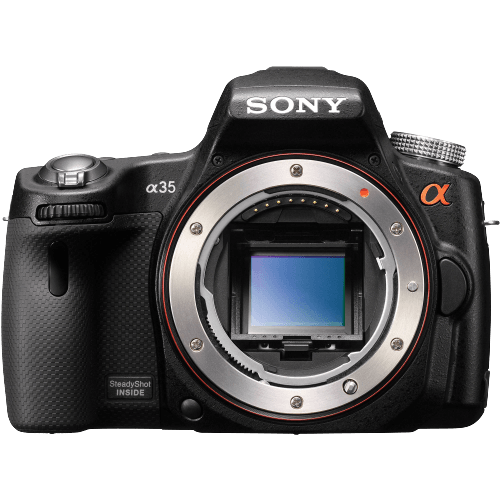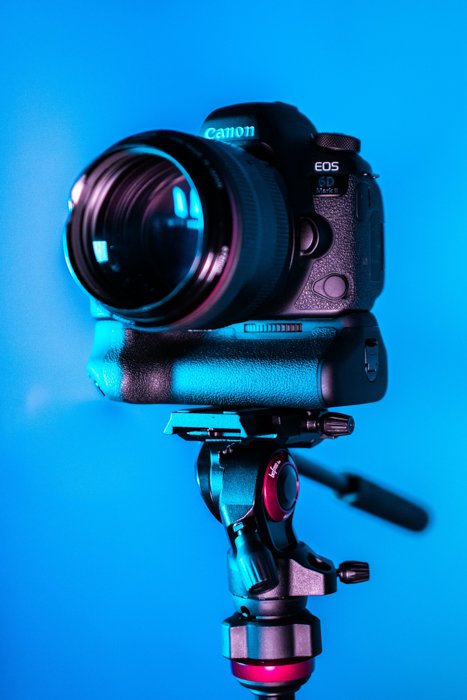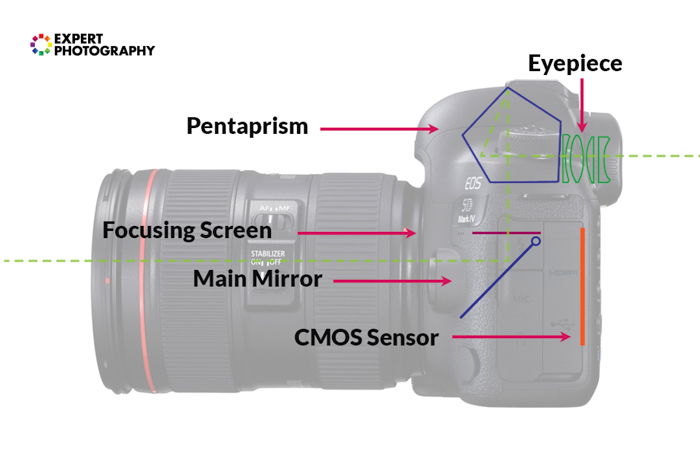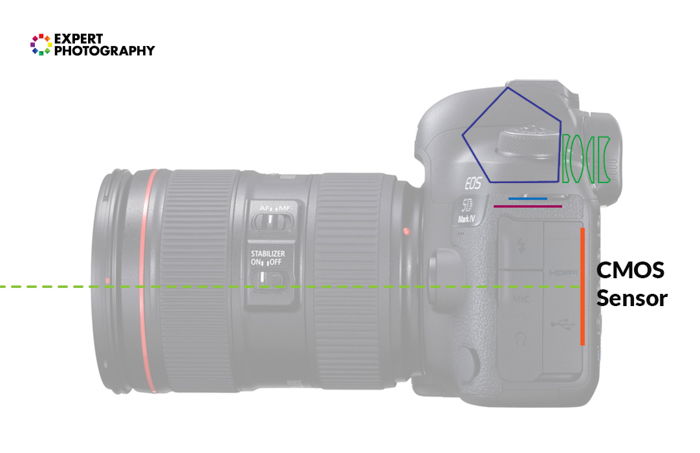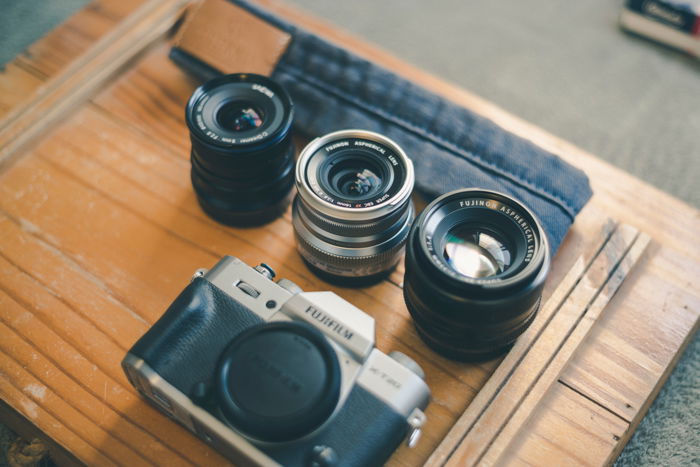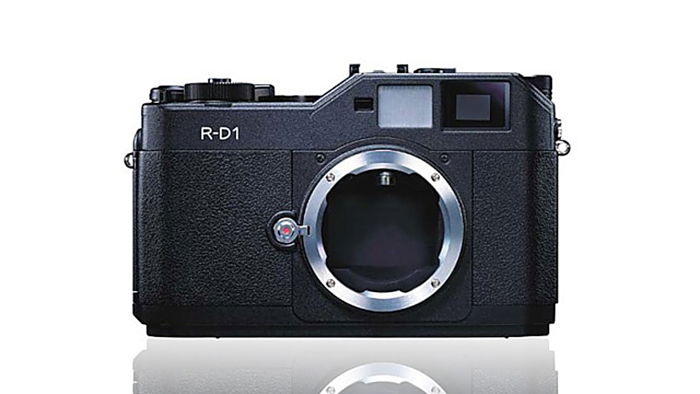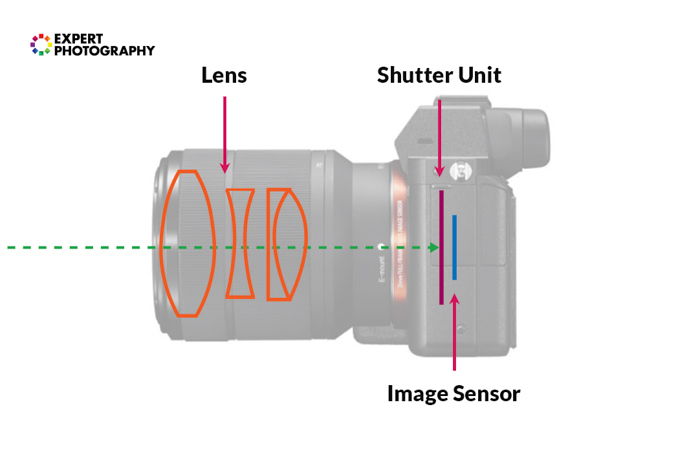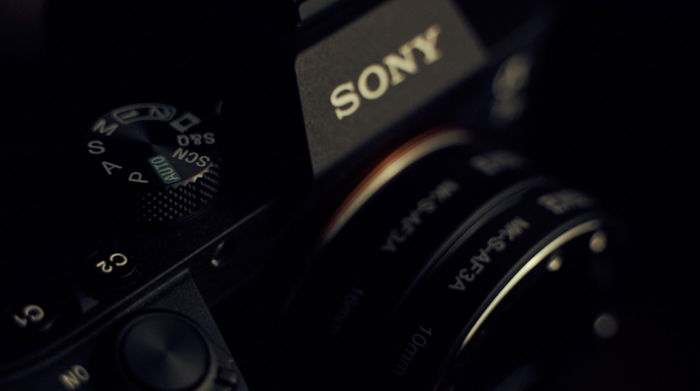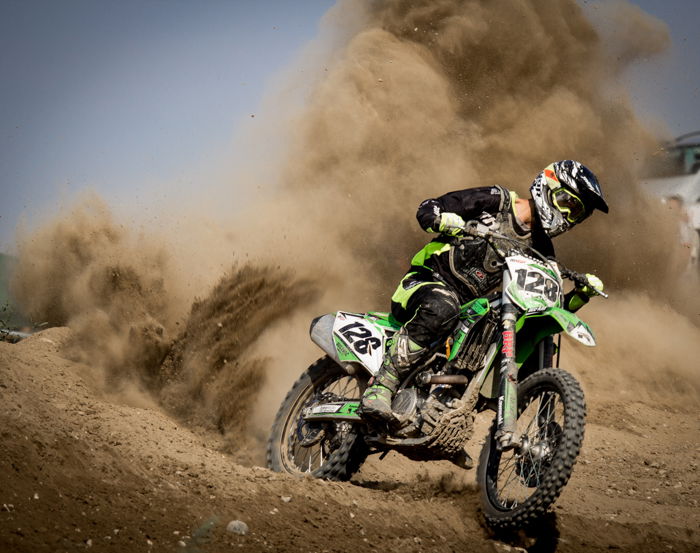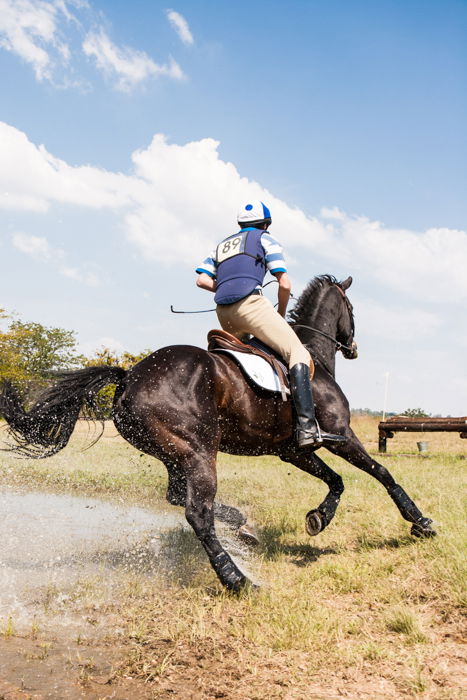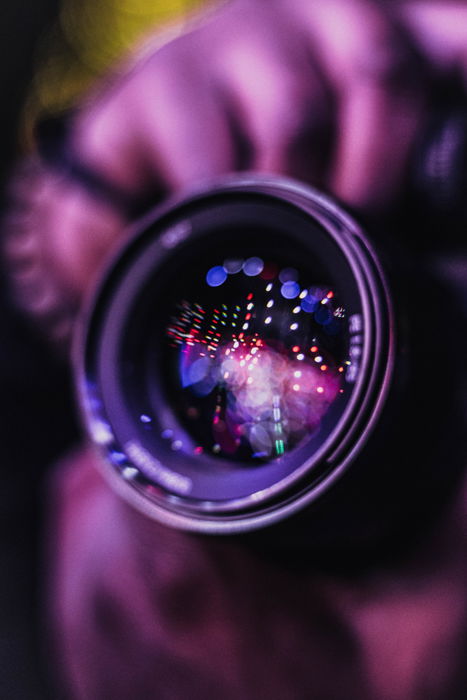There are several differences to consider. The speed of the autofocus, image resolution, and low-light performance come to mind. However, both types of cameras can give you high-quality images. The debate between mirrorless vs DSLR can be just as heated as Nikon vs Canon for photographers. But we aim to give you unbiased information from both sides so you can decide for yourself. So why choose one over the other? If you’re going to spend a lot of money on a mirrorless or digital camera, it’s best to read on to find out. [ExpertPhotography is supported by readers. Product links on ExpertPhotography are referral links. If you use one of these and buy something, we make a little bit of money. Need more info? See how it all works here.]
Mirrorless Vs Dslr: What is a DSLR Camera?
DSLR stands for ‘Digital Single-Lens Reflex’. The word ‘digital’ refers to the sensor the camera contains. ‘Single-Lens’ indicates the difference between DSLR and older camera types. Rangefinder and twin-lens-reflex cameras had to rely on either two lenses or other methods to predict what was incorporated in the frame. ‘Reflex’ explains the movement that the mirror makes the moment the picture is taken. It flips up, directing the incoming light towards the viewfinder. DSLRs are the most widely used type of camera bodies. They offer a range of different lenses and features that revolutionised photography.
History of DSLR Cameras
Film cameras posed some problems. One problem was the difficulty in seeing what you were about to take a picture of beforehand. The photographer had to rely on a viewfinder that showed a similar but not identical view. An innovative solution to this problem was the addition of an extra identical lens to the camera system. Instead of one lens, there were two lenses. One the photographer peered through, and one to form the image on the film. SLR cameras were created to overcome the drawbacks of rangefinder cameras. Problems included zone focusing and the low-level handle issues with TLR (twin-lens-reflex) systems. One invention revolutionized by SLRs was through-the-lens metering. In the 1990s, digital sensors and processing alternatives came to the market. After people realised how much easier the photography process was with DSLR’s, more people started using them. Eventually, this led to DSLRs replacing film cameras.
Anatomy of DSLR Cameras
Over a hundred years after the first camera was invented, its basic structure is still incorporated into modern digital cameras. The most important components of the DSLR are shown in the simplified diagram below.
When the shutter button is pressed, the optical path for light is rearranged to look like this:
Once the shutter has exposed the sensor to light, it closes again—ready for the next shot. A spring returns the mirror to its resting position (except when you use mirror lockup) Originally, a DSLR read data from the sensor only after an image had been taken. DSLR manufacturers realised the mirror could continue reading the sensor before the photographer took the photo. This continuous stream of image data resulted in the ability to make videos and have a live view. And now, it is a standard feature on all advanced DSLRs.
What is a Mirrorless Camera?
Mirrorless cameras, as their name suggests, don’t have a built-in mirror. For this reason, they generally tend to be much more lightweight than the DSLR design. They are more compact, take up less space, and are built around electronic features.
History of Mirrorless Cameras
The first mirrorless camera was made by Epson in 2004. It came with an APS-C sensor and a 1:1 optical viewfinder. Soon after this model was released, many other manufacturers followed. Leica, Panasonic and Olympus were the next ones to get mirrorless cameras into the market. They consisted mainly of Micro Four Thirds cameras.
Sony, Nikon and Samsung followed the trend, but their cameras were nowhere close to beating the market-leader DSLRs. However, Sony Alpha A7 and 7R were the game changers of the mirrorless industry. Those were the first mirrorless cameras with full frame sensors. They also offered an outstanding autofocus system. They created a new standard and redefined what mirrorless cameras meant in the world of photography. Since then, we can safely say that mirrorless bodies are starting to outrank their DSLR equivalents. All major camera brands have recognised this over the past years. They are now putting a lot more effort into advancing mirrorless systems.
Anatomy of Mirrorless Cameras
Modern mirrorless cameras have no optical viewfinder, thus no pentaprism. The light passes directly onto the digital sensor. This is how it displays the image on the LCD screen or in the electronic viewfinder:
Mirrorless bodies are mainly digital, so they have a simpler mechanism. Noise, vibration and reliability are all due to the movement of the mirror. Thus, removing the mirror has several advantages. It reduces camera shake because there is nothing inside the camera that moves when you take the picture. However, since the mirror is removed, nothing is between the lens and the shutter. This can cause dust to get into the sensor more easily. It is a problem that outdoor photographers should consider when deciding between a mirrorless vs DSLR camera.
DSLR vs Mirrorless Cameras: Mechanics and Build Quality
1. Size
Due to the differences in their components, mirrorless cameras are smaller. Removing the mirror and the prism means that they are not as heavy as DSLR bodies. Even when it comes to bodies that provide the same sensor size, mirrorless lenses are smaller. This results in better overall portability.
2. Viewfinder
As there is no mirror in front of the sensor, the picture from the lens goes straight to the LCD screen that allows a live view. For this reason, there is no mechanical viewfinder in mirrorless cameras. However, most models offer an electronic viewfinder that displays the image directly from the sensor. Many photographers prefer mechanical viewfinders on DSLRs. They provide the most accurate representation of what our eyes see. And traditional viewfinders still take the lead in low light situations. But there are also advantages to using electronic viewfinders, such as their ability to display live histograms. In the end, it all comes down to personal preference.
3. Tiltable Screens
The LCD screen in mirrorless cameras are often tiltable. This is a helpful feature when you are shooting from a different perspective than your eye level. But recently, many newer DSLR models also offer this option.
4. Mechanical Components
Due to fewer mechanical components, mirrorless cameras are quieter. This can come in handy in certain situations, such as photographing wildlife or weddings.
5. Available Lenses
Camera manufacturers have started exclusively producing mirrorless lenses in the past years. But there are still not nearly as many choices as there are for DSLR cameras. Luckily, you can get an adapter that allows you to attach DSLR lenses to mirrorless mounts.
Mirrorless vs DSLR: Sensor
Comparing megapixels when talking about image quality and performance is misleading. It matters more how big the sensor is, whether Micro Four Thirds, APS-C, or Full Frame. You can get both crop and full frame cameras in DSLR and mirrorless systems. Smaller image sensors are more cost-effective. And their smaller size meant that the lenses used to form the image could be smaller, lighter and cheaper. Many mirrorless models use Micro Four Thirds. This is an even smaller sensor than APS-C. It means that the lens can also be smaller. And their crop factor magnification (2x) doubles your focal length. This can come in handy for areas of photography where you use long telephoto lenses, such as sports and wildlife. However, larger camera sensors have better image quality. They generally take sharper images, and the colors are more accurate. They allow more light in, meaning that their low-light performance is better. Also, their depth of field is shallower with the same settings compare to crop sensor cameras. If you are looking for more information on crop sensors vs full frame sensors, you need to read this article. <img class=“aligncenter” src=“https://expertphotography.com/wp-content/uploads/2017/03/sensorSizes.jpg" alt=“diagram with Sony RX 100M3, Canon EOS 50D APS-C and 5D MkIII full frame sensor sizes compared” width=”700″ height=”319″ /> When you look at the anatomy of DSLR cameras, you can see that the mirror is in front of the sensor, protecting it from the outer world. As mentioned earlier, there is no mirror in mirrorless cameras. Therefore, dust can get into the sensor more easily. And this can be a problem for photographers who often change lenses out in the field, in environments where dust and dirt can get into the camera.
Mirrorless vs DSLR: Autofocus Features
For many niches of photography, such as sport or wildlife photography, the autofocus system in the camera is of prime importance. There are two main methods of autofocusing; contrast and phase detection.
Contrast Autofocus
Early mirrorless or DSLR cameras use a process called ‘contrast detection’. This works by analyzing a part of the image. It checks if there are any sharp transitions between light and dark. In practice, this causes the lens to ‘hunt’ for the focus. This makes this method of auto-focus frustratingly slow. In its favour, contrast detection is capable of achieving very accurate focusing.
Phase Detection Autofocus
The other autofocus method you’ll find is ‘phase detection’. This works by splitting rays of light from the object. These are then focused into two beams on opposite sides of the lens diameter.
The camera compares how the two beams line up on a special light-sensitive strip. This creates a rangefinder system. Unlike contrast detection, this method can determine which way to turn the focus ring on the lens. There is no hunting back and forth, so the autofocus is fast and responsive. Consider Canon’s EOS-1DX Mark II (a DSLR camera) as an example. It can autofocus while firing off sixteen exposures per second.
Hybrid Autofocus
In recent years, some striking developments have taken place with the mirrorless autofocus system. These cameras now come with dedicated phase detection pixels built into their sensors. This has enabled them to take advantage of the speed of phase detection autofocus. At the same time, adding the fine-tuning accuracy of contrast detection. Camera manufacturers started combining contrast and phase-detection autofocus in a hybrid system. This resulted in improved speed and accuracy. An example of this is Canon’s Dual Pixel autofocus technology.
Other Autofocus Features
Newer mirrorless cameras also include revolutionary features such as Sony’s eye-tracking AF. These cameras’ electronic shutter allows a higher burst ability. It is close to overcoming the performance of high-end DSLR cameras. Mirrorless cameras also offer focus peaking that improves focusing accuracy in manual mode. Overall, mirrorless autofocus systems keep improving with software updates. This has put DSLR cameras in second place. For example, Canon M50 Mark II and the Olympus E-M10 Mark IV delivers some impressive performances.
Mirrorless vs DSLR: General Features
When it comes to DSLR vs mirrorless camera features, it is difficult to say which system offers more. Both have an extended amount of manual controls that make them suitable for various photography conditions. While introducing video captures in DSLR cameras for the first time was a breakthrough, it is now a standard feature in mirrorless cameras. Most mirrorless cameras have 4K video capabilities and improved continuous focusing systems. This makes them a lot more suitable for those who are planning to shoot videos.
There are also additions to mirrorless cameras that our digital age has inspired. You are much more likely to find them compatible with Wi-Fi and smartphone applications than DSLRs. And they have more up-to-date options such as touchscreens that DSLRs don’t. On the other hand, there are some DSLR features that mirrorless cameras cannot compete with. When it comes to the quality of built and sturdiness, DSLRs take the lead. Their weather sealing is also better, making them suitable for difficult outdoor conditions. Plus, you can find more physical buttons and user-friendly menus in DSLR camera bodies. Generally speaking, DSLRs continue on a more traditional and dependable path. Meanwhile, mirrorless systems are changing their features for the better in unison with technological advances.
Conclusion: Mirrorless vs DSLR
All camera manufacturers are developing mirrorless systems these days. And mirrorless cameras may be on the verge of outperforming DSLRs in every kind of photography, from landscape to sport. But if you have already invested in a DSLR system and have a good selection of lenses, don’t worry. There’s no need to sell all your gear. If you decide that a mirrorless system fits your needs more, you can always buy an adapter that allows you to use DSLR lenses with mirrorless bodies. Digital imaging technology continues its relentless march forward. This means buying a camera can be like hitting a moving target. We hope this article has clarified your choice between mirrorless and DSLR cameras. And let us know if it has helped you make an informed decision on which one to buy! Are you new to photography? Try our fun and easy Photography for Beginner’s course!
